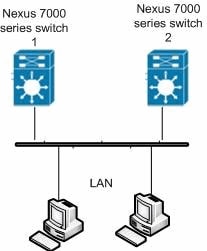Nexus 7000 Series Switch GLBP Configuration Example
Available Languages
Contents
Introduction
This document describes how to configure the Gateway Load Balancing Protocol (GLBP) on a Nexus 7000 Series Switches to share the load of the default gateway on a LAN.
Prerequisites
Requirements
Ensure that you meet these requirements before you attempt this configuration:
-
Have basic knowledge of configuration on Nexus 7000 Series Switches
-
Have basic understanding of gateway load balancing protocol (GLBP)
Components Used
The information in this document is based on Nexus 7000 Series NX-OS devices.
The information in this document was created from the devices in a specific lab environment. All of the devices used in this document started with a cleared (default) configuration. If your network is live, make sure that you understand the potential impact of any command.
Conventions
Refer to the Cisco Technical Tips Conventions for more information on document conventions.
Background Information
About GLBP
-
GLBP provides gateway backup for IP hosts by sharing virtual IP address and virtual Media Access Control (MAC) address between the gateways involved in GLBP group.
-
GLBP allows gateways to share the load of the default gateway on an IEEE 802.3 LAN.
-
When compared to Hot Standby Router Protocol (HSRP) and Virtual Router Redundancy Protocol (VRRP), GLBP performs an additional load balancing function that the other protocols do not provide.
-
GLBP load balances over multiple routers (gateways) with the use of a single virtual IP address and multiple virtual MAC addresses, and also provides redundant gateways that become active if any of the existing forwarding gateways fail.
-
GLBP shares the forwarding load among all routers in a GLBP group.
-
GLBP members communicate between each other with the use of periodic hello messages.
Configure
-
In this section, you are presented with the information to configure GLBP on two Nexus 7000 Series Switches.
-
First globally enable the GLBP feature on both the switches.
-
You can only configure GLBP on Layer 3 interfaces.
-
The GLBP virtual IP address must be in the same subnet as the interface IP address.
-
You should configure all customization options for GLBP on all GLBP member gateways before enabling a GLBP group with the configuration of a virtual IP address.
Note: Use the Command Lookup Tool (registered customers only) to obtain more information on the commands used in this section.
Network Diagram
This document uses this network setup:

Configurations
This document uses these configurations:
| Nexus 7000 switch 1 |
|---|
Nexus1#configure terminal !--- Enables GLBP. Nexus1(config)#feature glbp Nexus1(config)#interface Vlan2 Nexus1(config-if)#ip address 10.193.33.252/24 !--- Creates a GLBP group. Nexus1(config-if)#glbp 2 !--- Configures the hello and hold times. Nexus1(config-if-glbp)#timers 1 4 !--- Configures the redirect and timeout timers. Nexus1(config-if-glbp)#timers redirect 600 7200 !--- Sets the priority level. Nexus1(config-if-glbp)#priority 10 Nexus1(config-if-glbp)#preempt delay minimum 60 !--- Sets the GLBP load-balancing method. Nexus1(config-if-glbp)#load-balancing host-dependent Nexus1(config-if-glbp)#forwarder preempt delay minimum 50 !--- Enables GLBP on an interface. Nexus1(config-if-glbp)#ip 10.193.33.3 Nexus1(config-if-glbp)#exit !--- Save the configurations in the device. Nexus1(config)#copy running-config startup-config Nexus1(config)#exit |
| Nexus 7000 switch 2 |
|---|
Nexus2#configure terminal !--- Enables GLBP. Nexus2(config)#feature glbp Nexus2(config)#interface Vlan2 Nexus2(config-if)#ip address 10.193.33.251/24 !--- Creates a GLBP group. Nexus2(config-if)#glbp 2 !--- Configures the hello and hold times. Nexus2(config-if-glbp)#timers 1 4 !--- Configures the redirect and timeout timers. Nexus2(config-if-glbp)#timers redirect 600 7200 !--- Sets the priority level. Nexus2(config-if-glbp)#priority 110 Nexus2(config-if-glbp)#preempt delay minimum 60 !--- Sets the GLBP load-balancing method. Nexus2(config-if-glbp)#load-balancing host-dependent Nexus2(config-if-glbp)#forwarder preempt delay minimum 50 !--- Enables GLBP on an interface. Nexus2(config-if-glbp)#ip 10.193.33.3 Nexus2(config-if-glbp)#exit !--- Save the configurations in the device. Nexus2(config)#copy running-config startup-config Nexus2(config)#exit |
Verify
Use this section in order to confirm that your configuration works properly.
The Output Interpreter Tool (registered customers only) (OIT) supports certain show commands. Use the OIT to view an analysis of show command output.
Use the show glbp command in order to display the GLBP settings and status.
For example:
Nexus1(config-if-glbp)#show glbp
Extended-hold (NSF) is Disabled
Vlan2 - Group 2
State is Init (Interface is up)
1 state change(s), last state change(s) 00:01:11
Virtual IP address is 10.193.33.3
Hello time 1 sec, hold time 4 sec
Redirect time 600 sec, forwarder time-out 7200 sec
Preemption enabled, min delay 60 sec
Active is unknown
Standby is unknown
Priority 110 (configured)
Weighting 100 (default 100), thresholds: lower 1, upper 100
Load balancing: host-dependent
Group members:
0026.980C.2AC1 (10.193.33.252) local
There are no forwarders
Use the show running-config interface vlan2 command in order to display information about the running configuration for VLAN interface 2.
For example:
Nexus1(config-if-glbp)#show running-config interface Vlan2
version 5.1(2)
interface Vlan2
no ip redirects
ip address 10.193.33.252/24
glbp 2
ip 10.193.33.3
timers 1 4
timers redirect 600 7200
priority 110
preempt
preempt delay minimum 60
load-balancing host-dependent
forwarder preempt delay minimum 50
These are some of the GLBP verification commands:
Troubleshoot
There is currently no specific troubleshooting information available for this configuration.
Related Information
Revision History
| Revision | Publish Date | Comments |
|---|---|---|
1.0 |
29-Mar-2012 |
Initial Release |
Contact Cisco
- Open a Support Case

- (Requires a Cisco Service Contract)
 Feedback
Feedback